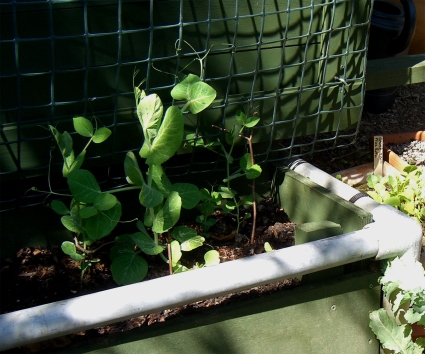
Pea bed (23 May 2020). The far plant is a squash.
Peas are a type of legume and are relatively easy to grow.
Peas prefer a sunny sheltered site with moderately fertile, well-drained soil.
They are nitrogen-fixing, so need less fertilizer than other crops. They also prefer soil that is not freshly manured.
(Ooops! Our new raised bed does have added manure, as we filled it up with fresh bagged soil and manure after the bed was finished being constructed on top of a very heavy clay bed at the top of the stairs and at the side of the shed. But the peas seem to be growing well despite this.)
In terms of kitchen garden plot rotations, peas are said to be a good crop to precede brassicas.
Make sure to start with weed-free soil, as peas are difficult to weed once they get growing.
Peas may need protection from birds (especially wood pigeons).
Sow 1-2 inches (2.5-5cm) deep in shallow, flat bottomed trenches around 6 inches (15 cm) wide.
Space seeds 2-3 inches (5-7cm) apart – further for taller cultivars, closer together for dwarf types.

Pea bed (30 May 2020)
Early selections can be sown in late winter or early spring for an early summer crop.
Sow successively until early summer.
Water during dry spells if flowering.
Sow hardy (round seeded) over-wintering types (such as Douce Provence) in mid- or late-autumn for a late-spring crop. In colder areas these may need cloches or a covering of garden fleece to survive the winter.
One of the best methods of supporting peas is to stretch netting between posts or canes around your row of peas, creating a pea ‘hedge’, with plants supported from all sides.
Use scissors when harvesting as stems are fragile. Pick as soon as pods are ready.
If your peas have gone over you can dry them and make your own mushy peas or pea soup. Or save them for next year as peas usually come true from seed.
TYPES OF PEA
Edible pods – sugar snaps or mangetout.
Leafless Peas – pea shoots
Shelling Peas – most of the traditional cultivars.
